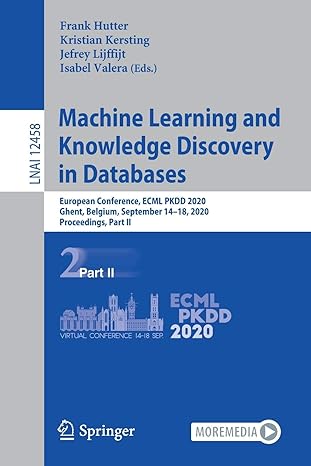Question
Problem In mathematics, a magma is a type of algebraic structure that has a set of elements, all of the same type, and one binary
Problem
In mathematics, a magma is a type of algebraic structure that has a set of elements, all of the same type, and one binary operation. Such a pairing of a set (ex. Positive integers) with this operation is a semigroup when the opearation is associative and produces an element from the same set.
Another common algebraic structure features a unary operation that is its own inverse, commonly called the complement. One example is the boolean complement operator, which takes a boolean and produces a boolean. By definition, applying a complement operator twice gives the original value.
In this assignment, you will create a generic complementable interface and semigroup abstract class that support some general operations. You will then create fully concrete implementations of some familiar semigroups: positive integers paired with common addition, and RGB colors paired with a combination operation (e.g., averaging the color components of the two operands). You will also implement the complementable interface.
Complementable Interface
Define a typed interface Complementable that specifies the complement operation. Because this will be an object method, it takes no argument but produces an object of the (parameterized) complementable type. This is similar to the java.lang.Iterator interface.
BinaryWord Class
Create a BinaryWord class implementing the Complementable interface. Use java.util.BitSet as the underlying storage container. While the BinaryWord constructor implementation is up to you, using a String argument may be the most straightforward.
The complement operation should yield a bitwise inversion of the word. For instance, the complement of 001011 would be 110100.
You should also implement equals and toString methods for later testing. What should the parameterized type be for the implements clause? If you're confused, you might refer to the java.lang.Comparable interface and also see the declaration of the Integer class in the Java API, as well as the java.lang.Iterator interface and the declaration of the java.util.Scanner class.
Semigroup Class
Recall that a semigroup requires a binary operation, which means the operation takes two arguments.
Define an abstract, typed class Semigroup that species an operator operation, which takes one argument. (Note that the other implicit argument of the operation is the object receiving the method call.) Some aspects of this will be similar both to the Comparator and java.lang.Iterable interfaces.
Semigroup objects should be immutable; that is, any operations should return new objects of the generic type, rather than being mutators. Note that we do not yet have any shared implementations, so this class will not actually do much - yet. (That is, its functionally similar to an interface.)
PositiveInteger Class
Create a (concrete) subclass of Semigroup called PositiveInteger.
What should the parameterized type be for the extends clause? This is similar to Complementable, except BinaryWord implements a generic interface while PositiveInteger extends a generic class. Implement the required method of the class (operator) using the typical add operation on integers. You should also implement equals and toString methods for later testing.
RGBColor Class
Create another (concrete) subclass of Semigroup called RGBColor. It should store three integers in the range 0-255. Because colors have complements, RGBColor should also implement the Complementable interface.
The operator of the Semigroup will be color blending. That is, the components of the new color should be the (integer) average of the components of the two input colors. The complement operation should give a new color whose components are each 255 minus the original.
For example, if [R/G/B] represents the three color components, the operator on [32/96/128] and [0/99/255] would yield [16/97/191]. The complement of the former would be [223/159/127].
Expanding Semigroup
An abstract class may as well be an interface if it has no members or concrete methods. Let's rectify that.
Add one static method to your Semigroup class called combine that will compute accumulate the operator results sequentially for all the elements in a Collection (the parent interface of ArrayList) of any Semigroup objects. For example, employing the combine method on a collection of PositiveIntegers would yield their sum.
You should use Java's enhanced for loop. We will take as a precondition that the collection is nonempty. Note that every item in the given Collection must be the same kind of Semigroup object, otherwise you probably would not be able to combine them (e.g., what's the operation on 5 and yellow??!?). Note that Collection will need to be imported from java.util.
Testing
Demonstrate the functionality of your concrete classes and the additional static methods with a suite of appropriate unit tests that show the generic static methods working for both types of semigroups.
Step by Step Solution
There are 3 Steps involved in it
Step: 1

Get Instant Access to Expert-Tailored Solutions
See step-by-step solutions with expert insights and AI powered tools for academic success
Step: 2

Step: 3

Ace Your Homework with AI
Get the answers you need in no time with our AI-driven, step-by-step assistance
Get Started


